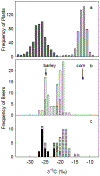Applying the principles of isotope analysis in plant and animal ecology to forensic science in the Americas
- PMID: 29955984
- PMCID: PMC6606046
- DOI: 10.1007/s00442-018-4188-1
Applying the principles of isotope analysis in plant and animal ecology to forensic science in the Americas
Abstract
The heart of forensic science is application of the scientific method and analytical approaches to answer questions central to solving a crime: Who, What, When, Where, and How. Forensic practitioners use fundamentals of chemistry and physics to examine evidence and infer its origin. In this regard, ecological researchers have had a significant impact on forensic science through the development and application of a specialized measurement technique-isotope analysis-for examining evidence. Here, we review the utility of isotope analysis in forensic settings from an ecological perspective, concentrating on work from the Americas completed within the last three decades. Our primary focus is on combining plant and animal physiological models with isotope analyses for source inference. Examples of the forensic application of isotopes-including stable isotopes, radiogenic isotopes, and radioisotopes-span from cotton used in counterfeit bills to anthrax shipped through the U.S. Postal Service and from beer adulterated with cheap adjuncts to human remains discovered in shallow graves. Recent methodological developments and the generation of isotope landscapes, or isoscapes, for data interpretation promise that isotope analysis will be a useful tool in ecological and forensic studies for decades to come.
Keywords: Criminal investigation; Drug; Food and beverage; Human remains; Wildlife.
Conflict of interest statement
Figures





Similar articles
-
From stable isotope ecology to forensic isotope ecology - Isotopes' tales.Forensic Sci Int. 2019 Jul;300:89-98. doi: 10.1016/j.forsciint.2019.04.023. Epub 2019 Apr 27. Forensic Sci Int. 2019. PMID: 31085431 Review.
-
Evaluation of the efficacy of spatiotemporal Pb isoscapes for provenancing of human remains.Forensic Sci Int. 2016 Apr;261:83-92. doi: 10.1016/j.forsciint.2016.02.006. Epub 2016 Feb 12. Forensic Sci Int. 2016. PMID: 26914828
-
Applications of Isotopes in Forensic Science.J Labelled Comp Radiopharm. 2025 Apr;68(4):e4141. doi: 10.1002/jlcr.4141. J Labelled Comp Radiopharm. 2025. PMID: 40152090 Review.
-
Planning Implications Related to Sterilization-Sensitive Science Investigations Associated with Mars Sample Return (MSR).Astrobiology. 2022 Jun;22(S1):S112-S164. doi: 10.1089/AST.2021.0113. Epub 2022 May 19. Astrobiology. 2022. PMID: 34904892
-
Global application of stable hydrogen and oxygen isotopes to wildlife forensics.Oecologia. 2005 Apr;143(3):337-48. doi: 10.1007/s00442-004-1813-y. Epub 2005 Feb 23. Oecologia. 2005. PMID: 15726429
Cited by
-
A 3-D groundwater isoscape of the contiguous USA for forensic and water resource science.PLoS One. 2022 Jan 7;17(1):e0261651. doi: 10.1371/journal.pone.0261651. eCollection 2022. PLoS One. 2022. PMID: 34995313 Free PMC article.
-
Strontium, oxygen, and carbon isotope variation in modern human dental enamel.Am J Phys Anthropol. 2020 Aug;172(4):586-604. doi: 10.1002/ajpa.24059. Epub 2020 Apr 25. Am J Phys Anthropol. 2020. PMID: 32333689 Free PMC article.
-
Examination of amino acid hydrogen isotope measurements of scalp hair for region-of-origin studies.Rapid Commun Mass Spectrom. 2023 Feb 28;37(4):e9442. doi: 10.1002/rcm.9442. Rapid Commun Mass Spectrom. 2023. PMID: 36411248 Free PMC article.
-
Tracking cats revisited: Placing terrestrial mammalian carnivores on δ2H and δ18O isoscapes.PLoS One. 2019 Sep 3;14(9):e0221876. doi: 10.1371/journal.pone.0221876. eCollection 2019. PLoS One. 2019. PMID: 31479471 Free PMC article.
-
Evaluation of neodymium isotope analysis of human dental enamel as a provenance indicator using 1013 Ω amplifiers (TIMS).Sci Justice. 2019 May;59(3):322-331. doi: 10.1016/j.scijus.2019.02.001. Epub 2019 Feb 4. Sci Justice. 2019. PMID: 31054821 Free PMC article.
References
-
- Ambrose SH, Krigbaum J (2003) Bone chemistry and bioarchaeology. Journal of Anthropological Archaeology 22:191–192. doi: 10.1016/S0278-4165(03)00032-1 - DOI
-
- Amundson R, Austin AT, Schuur EAG, et al. (2003) Global patterns of the isotopic composition of soil and plant nitrogen. Global Biogeochemical Cycles 17. doi: 10.1029/2002GB001903 - DOI
Publication types
MeSH terms
Substances
Grants and funding
LinkOut - more resources
Full Text Sources
Other Literature Sources

